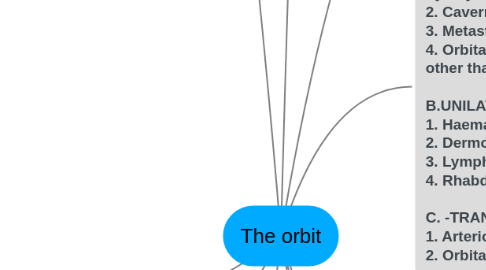
1. # Inflammatory disorder: - sarcoidosis. -orbital pseudotumor0 -non -specific lymphofibro_blastic disorder.
2. # Infective disorder: - Orbital cellulitis. - Preseptal cellulitis.
2.1. PERIORBITAL CELLULITIS
2.1.1. * Involves the tissues anterior to the orbital septum
2.1.2. *Complications: 1. Orbital abscess 2. Orbital mucocele
2.1.3. *Relative recession (backward or downward displacement) of the globe into the bony orbit.
2.2. ORBITAL CELLULITIS
2.2.1. *Inflammation and infection of the orbital soft tissues posterior to the orbital septum.
2.2.2. *symptoms: -painful, proptosed eye; - conjunctival injection; - periorbital inflammation and swelling; - reduced eye movements; -possible visual loss; - systemic illness and pyrexia.
2.2.3. *complications: -Brain abscess -Cavernous sinus thrombosis -Meningitis - blindness
2.2.4. *diagnosis: • 1. Mainly by clinical evaluation • 2. MRI (CST) • 3. CT Scan
2.2.5. *Treatment: • Admission & Broad spectrum IV antibiotics. • draining the abscess • Orbital decompression
3. TRAUMA
4. # Orbital tumors: -lacrimal gland tumours -optic nerve gliomas - meningiomas -lymphomas -rhabdomyo_sarcomas -metastasis
4.1. Secondary (mets)
4.1.1. • metastasis from other systemic cancers ; • (neuroblastomas in children) • (the breast 40%, lung, prostate or gastrointestinal tract in adults).
5. # Vascular abnormalities: - carotid cavernous fistula - Orbital varices(varix) - Capillary hemangioma
5.1. Capillary Hemangiomas
5.1.1. *They are benign endothelial cell neoplasms that lead to vessle growth stimulation.
5.1.2. *symptoms: - red Swelling of the upper lid - may cause sufficient ptosis - cause amblyopia.
5.1.3. *Treatment: - local injections of steroids. - Incisional surgical
6. ##CAUSES OF PROPTOSIS : A. BILATERAL PROPTOSIS 1. Endocrine exophthalmos due to dysthyroid eye disease. 2. Cavernous sinus thrombosis. 3. Metastatic neuroblastoma. 4. Orbital myositis (due to causes other than thyroid dysfunction). B.UNILATERAL PROPTOSI : 1. Haemangioma.- 2. Dermoid 3. Lymphangioma. 4. Rhabdomyosarcoma. C. -TRANSIENT PROPTOSIS 1. Arterio-venous malformations. 2. Orbital varices.
7. # Disorders of the extra ocular muscles : - Dysthyroid eye disease. - Ocular myositis.
7.1. Dysthyroid Eye Disease
7.1.1. * symptoms: - red painful eye. -double vision. -reduced visual acuity.
7.1.2. *Autoimmune disorder with orbital involvement frequently associated with thyroid dysfunction. *90% occurs in smokers.
7.1.3. *Sign : - proptosis. -chemosed. -The upper lid may be retracted. -The upper lid may lag. - restricted eye movements.
7.1.4. *Complications: - corneal ulcers. -corneal perforation. -blindness
7.1.5. *investigation: -thyroid function tests; - anti thyroid antibodies. -Orbital CT & MRI.
7.1.6. *Management: -Emergency >> systemic steroids -The long term >> The first step is the regulation of thyroid hormones levels-Artificial tears-Glasses-Stop smoking.
7.2. Ocular myositis
7.2.1. *This is an inflammation of the extraocular muscles
7.2.2. *symptoms - pain. -diplopia. - restriction in the movement of the involved muscle.
7.2.3. *investigation: -CT or MRI.
7.2.4. *treatment: -steroids.

